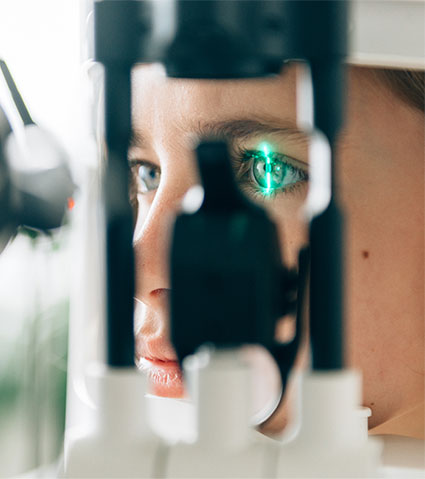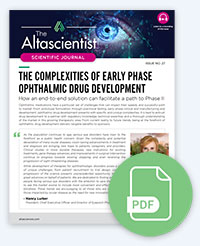Ophthalmic Drug Development Solutions
As a leading partner in ocular therapy, Altasciences is at the forefront of ophthalmic drug development. Our integrated CRO/CDMO solutions can support your program from lead candidate selection to market. You will benefit from working with a single partner as your product advances through each phase of drug development—from prototype formulation through preclinical testing, to early-phase clinical trials, and manufacturing. This could mean up to 40% in time savings.
Our End-To-End Ophthalmic Solutions
Ophthalmic Formulation, Manufacturing, And Analytical Services (CDMO)
Altasciences’ cGMP, FDA-registered and inspected manufacturing facility is DEA-licensed for schedule I-V drugs, and equipped with R&D and formulation laboratories, as well as Grade C and D manufacturing suites for the handling of highly potent compounds and controlled substances. Our scientific experts have extensive experience working with complex ocular drug products in addition to terminally sterilized solutions and suspensions.
Our specialties include:
- Formulation and development of highly potent APIs, topicals, and terminally sterilized injectables
- Micro and nanoparticulate formulations
- Bioadhesive, monograph-compliant topical excipients
- High-performance mucoadhesive topical excipients
- Finished dosage form manufacturing and packaging
- Method development, validation, and ICH stability testing
- Regulatory and technical support
We formulate and develop a vast range of ophthalmic dosage forms and offer flexible filling options that can accommodate different scales from small batches up to 400 liters. Fillable containers include multi-dose bottles, vials, droppers, pre-filled syringes, cartridges, and tubes—we can also create customized containers.
![]()
Altasciences' Quality Assurance Team provides oversight on all manufacturing and release activities throughout the entire ophthalmic product development process. Testing is performed for:
- Water quality
- Absence of microbiological contamination
- Physical and chemical characteristics
- Adequacy of environmental conditions (environmental monitoring)
Discover our full range of manufacturing and analytical solutions.
Ophthalmic Preclinical Safety Testing
Altasciences has been conducting ophthalmic safety testing for over 50 years, resulting in numerous global regulatory submissions and not a single study rejected for reasons of design, conduct, or data integrity. We perform ocular pharmacokinetic (PK) studies in multiple species (rodent and non-rodent), with timelines ranging from 24 hours for single dose acute testing to as long as nine months.
Different formulations and routes of administration allow for optimal drug delivery and absorption in the target structure of the eye. Our highly skilled scientists consider the important differences in ophthalmic preparations before application. For example, a liquid formulation is quickly absorbed and releases drug rapidly but may require frequent administration. On the other hand, ointment, gels, and implants are generally used for slow drug release, and require less frequent administration.
| ROUTES OF ADMINISTRATION | FORMULATIONS |
| Topical | Liquid, suspension, ointment |
| Subconjunctival | Liquid, suspension, gel |
| Intracameral | Liquid |
| Intravitreal | Liquid, suspension, gel, implants |
| Subretinal | Liquid, cell delivery |
To support preclinical ophthalmology research, we utilize a broad range of techniques and specialized equipment, such as:
- Ophthalmic exams
- Ocular observations
- Intraocular pressure (IOP)
- RetCam shuttle camera
- Electroretinogram (ERG)
- Optical coherence tomography (OCT)
- Ocular tissue harvest
Throughout the preclinical ophthalmology testing phase, Altasciences collaborates with certified, on-site, boarded veterinary ophthalmologists (DACVO) to interpret results and delivers the SEND package within three weeks of your final report. Submission-ready datasets include XPT domains, Study Data Reviewer’s Guide (nSDRG), and Define.xml files compliant with CDISC specifications.
Learn more on our full range of ophthalmic preclinical testing solutions.
Listen to the Podcast―Nonclinical Considerations When Developing an Ophthalmic Drug.
Ophthalmic Clinical Research Services
Altasciences has completed more than 40 ophthalmology trials to assess the safety, side effects, dose requirements, and timing of new drug products intended for use in humans. We have three North American clinical research sites, from coast to coast, with over 500 beds and fully equipped inpatient and outpatient capabilities, for the conduct of first-in-human to Phase II clinical trials. To ensure the efficiency and accuracy of your studies, we have an in-house ophthalmologist as our Principal Investigator with over 20 years of experience, in addition to a strong network of ophthalmology sites in close proximity to our clinics.
Our database of over 400,000 participants includes healthy normal, special, and patient populations that have undergone extensive screening. We also have patient access through partnerships with hospitals and management of independent investigational sites.
Altasciences’ clinical pharmacology units have the latest equipment to perform various ophthalmic procedures. Our highly trained clinical personnel uses advanced technology and standardized protocols to obtain the quality of data sufficient for early detection of adverse events, and gain regulatory approval of the medication.
In addition to standard diagnostic devices, Altasciences has access to the following experience and tools used in ophthalmic clinical studies:
 Coordination of ophthalmic testing with intensive PK and PD clinical laboratory testing
Coordination of ophthalmic testing with intensive PK and PD clinical laboratory testing- Close coordination between ophthalmic and general medical treatments, evaluations, and testing (i.e., intravenous infusions, ERGs, radiological testing, and clinical laboratory testing)
- Clinical trial design, including genomic trials
- Best-corrected visual acuity (BCVA) using established Early Treatment of Diabetic Retinopathy Study (ETDRS) protocols
- Slit-lamp examinations and photography
- Standardized testing for dry eye or corneal toxicity
- IOP measurement
- Standardized installation of eye drops
- Gonioscopy
- Fundus photography
- Optical coherence tomography (OCT) of both the anterior and posterior segment
- Optical coherence tomography angiography (OCTA)
- Fluorescein angiography
- Multifocal electroretinography (mfERG)
- B-scan ultrasonography
Ophthalmic Bioanalysis
Altasciences’ bioanalytical scientists work in tandem with our preclinical, clinical, and research services groups to ensure the accurate collection, dissection, and handling of ocular samples, and confirm they are in alignment with the bioanalytical method in development.
We support both small and large molecules and perform bioanalysis for drug quantitation and assessment of systemic exposure, biomarkers, and immunogenicity. Our instrumentation and assay platforms (LC-MS/LBA) help us achieve low limits of quantitation for systemic exposure, and provide the ultra-low sensitivity necessary for plasma or serum TK/PK samples for ocular drug development. In addition, our ocular scientists have expertise working with rare and limited matrices such as tears.
Matrices
- Retina
- Vitreous humor and aqueous humor
- Conjunctiva
- Iris/ciliary body
- Sclera
- Optic nerve
- Cornea
- Lens
- RPE (retina pigment epithelium) choroid
- Tears
Species
- Human
- Rabbit
- Minipig
- Monkey
Working with a single CRO/CDMO partner that offers integrated end-to-end solutions mitigates the complexity and challenges of bringing ophthalmic therapeutics to market.
Altasciences has extensive expertise in the formulation, development, testing, and manufacturing of ocular drug products. We tackle the complexities of development with solutions that bring your product safely to patients, on time.
Learn about the key considerations and critical steps in each phase of ophthalmic drug development, including case studies, in this issue of The Altascientist.
